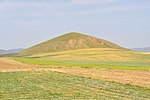Gaya Tumuli (Korean: 가야고분군) comprises seven tumuli complexes of the Gaya confederacy, from the 1st to the late 6th century CE. In 2023, seven tumuli complexes...
2 KB (55 words) - 00:08, 25 February 2024
Committee, held in Berlin, Germany, in 1995. The most recent site listed was Gaya Tumuli, in 2023. Getbol and the Jeju Volcanic Island and Lava Tubes are natural...
39 KB (1,051 words) - 22:28, 23 September 2024
on the History of Gaya in Korea", International Journal of Korean History, December 2000, 10–11. Tadashi Nishitani, "The Gaya Tumuli: Window on the Past"...
21 KB (2,998 words) - 00:46, 20 August 2024
and source of artistic inspiration". UNESCO. Retrieved 4 Aug 2013. "Gaya Tumuli". UNESCO. Retrieved 9 Sep 2023. "Getbol, Korean Tidal Flats". UNESCO...
67 KB (1,748 words) - 09:18, 19 April 2024
Korean art (section Gaya)
which are seen in Baekje and Silla. Many of the artifacts unearthed in Gaya tumuli are artifacts related to horses, such as stirrups, saddles, and horse...
45 KB (5,547 words) - 06:57, 1 June 2024
Natural 1697 Saudi Arabia 'Uruq Bani Ma'arid Natural 1699 South Korea Gaya Tumuli Cultural 1666 Spain Prehistoric Sites of Talayotic Menorca Cultural...
175 KB (799 words) - 12:09, 29 September 2024
Tumuli in Bokcheon-dong, Dongnae is located in Dongnae-gu, Busan Metropolitan City, the Republic of Korea. A number of tombs are scattered about this hillside...
1 KB (150 words) - 14:58, 18 August 2024
Silla crowns were uncovered in the tumuli of Gyeongju, South Korea, the capital of Silla and Unified Silla. Silla tumuli, unlike their Baekje and Goguryeo...
19 KB (1,077 words) - 08:23, 24 September 2024
believed to have originally been a branch of the sacred fig tree at Bodh Gaya (Bihar, India), under which the Buddha attained enlightenment. These vast...
31 KB (2,998 words) - 14:49, 5 August 2024





